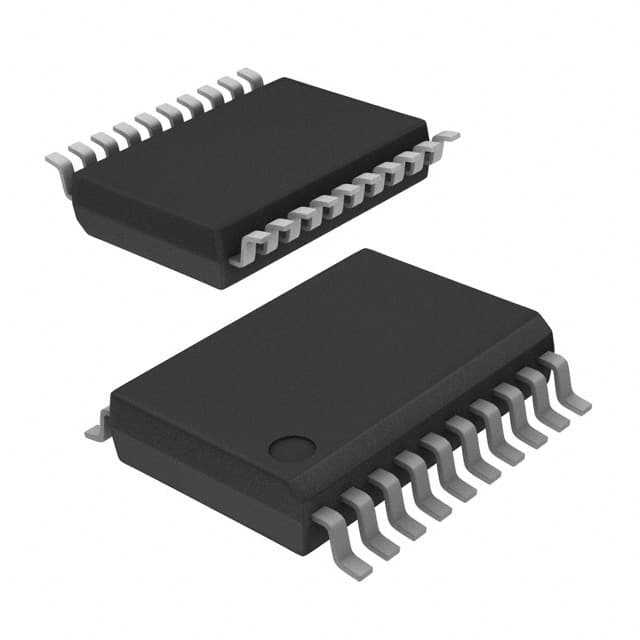74LV374DB,112
Basic Information Overview
- Category: Integrated Circuit (IC)
- Use: Flip-Flop / Latch
- Characteristics: Low-voltage CMOS octal D-type flip-flop with 3-state outputs
- Package: SSOP (Shrink Small Outline Package)
- Essence: This IC is a versatile flip-flop/latch that can store and control data in electronic circuits.
- Packaging/Quantity: Available in reels of 2,500 units
Specifications
- Supply Voltage Range: 1.65V to 5.5V
- High-Level Input Voltage: 2V (minimum), 0.7 x VCC (maximum)
- Low-Level Input Voltage: 0.8V (maximum), 0.3 x VCC (minimum)
- High-Level Output Current: -32mA (maximum)
- Low-Level Output Current: 64mA (maximum)
- Operating Temperature Range: -40°C to +125°C
Detailed Pin Configuration
The 74LV374DB,112 IC has a total of 20 pins, each serving a specific function. The pin configuration is as follows:
- Pin 1: Data Input (D0)
- Pin 2: Data Input (D1)
- Pin 3: Data Input (D2)
- Pin 4: Data Input (D3)
- Pin 5: Data Input (D4)
- Pin 6: Data Input (D5)
- Pin 7: Data Input (D6)
- Pin 8: Data Input (D7)
- Pin 9: Clock Input (CP)
- Pin 10: Output Enable Input (OE)
- Pin 11: Master Reset Input (MR)
- Pin 12: Q0 Output
- Pin 13: Q1 Output
- Pin 14: Q2 Output
- Pin 15: Q3 Output
- Pin 16: Q4 Output
- Pin 17: Q5 Output
- Pin 18: Q6 Output
- Pin 19: Q7 Output
- Pin 20: Ground (GND)
Functional Features
- The 74LV374DB,112 IC can store and control data using its eight D-type flip-flops.
- It has 3-state outputs, allowing for easy interfacing with other components in a circuit.
- The IC operates at low voltage, making it suitable for battery-powered devices.
- It offers high-speed operation and low power consumption.
Advantages and Disadvantages
Advantages: - Versatile and widely used in various digital applications. - Low-voltage operation extends battery life in portable devices. - High-speed operation enables efficient data processing.
Disadvantages: - Limited output current capacity may restrict certain applications. - Requires careful handling to prevent damage due to static electricity.
Working Principles
The 74LV374DB,112 IC functions as a latch or flip-flop by storing and controlling data. It operates based on the clock input (CP) signal, which triggers the transfer of data from the input pins (D0-D7) to the corresponding output pins (Q0-Q7). The output enable input (OE) controls whether the outputs are active or in a high-impedance state. The master reset input (MR) allows for resetting all flip-flops simultaneously.
Detailed Application Field Plans
The 74LV374DB,112 IC finds application in various digital systems, including but not limited to: - Microcontrollers and microprocessors - Data storage devices - Communication systems - Industrial automation - Consumer electronics
Detailed and Complete Alternative Models
- 74HC374: High-speed CMOS octal D-type flip-flop with 3-state outputs
- SN74LV374A: Low-voltage CMOS octal edge-triggered D-type flip-flop with 3-state outputs
- CD74HCT374: High-speed CMOS octal D-type flip-flop with 3-state outputs
These alternative models offer similar functionality and can be used as substitutes for the 74LV374DB,112 IC in various applications.
Word count: 440 words
Senaraikan 10 soalan dan jawapan biasa yang berkaitan dengan aplikasi 74LV374DB,112 dalam penyelesaian teknikal
Sure! Here are 10 common questions and answers related to the application of 74LV374DB,112 in technical solutions:
Q: What is the function of the 74LV374DB,112? A: The 74LV374DB,112 is an octal D-type flip-flop with 3-state outputs. It can store and transfer data in digital circuits.
Q: What is the voltage supply range for the 74LV374DB,112? A: The voltage supply range for the 74LV374DB,112 is typically between 1.65V and 5.5V.
Q: How many flip-flops are there in the 74LV374DB,112? A: The 74LV374DB,112 has eight flip-flops, making it an octal flip-flop.
Q: Can the 74LV374DB,112 be used in both synchronous and asynchronous applications? A: Yes, the 74LV374DB,112 can be used in both synchronous and asynchronous applications.
Q: What is the maximum clock frequency supported by the 74LV374DB,112? A: The maximum clock frequency supported by the 74LV374DB,112 is typically around 125 MHz.
Q: How does the 3-state output feature of the 74LV374DB,112 work? A: The 3-state output allows the outputs of the flip-flops to be disabled, effectively disconnecting them from the rest of the circuit.
Q: Can the 74LV374DB,112 be cascaded to increase the number of flip-flops? A: Yes, multiple 74LV374DB,112 chips can be cascaded together to increase the number of flip-flops in a circuit.
Q: What is the power consumption of the 74LV374DB,112? A: The power consumption of the 74LV374DB,112 is typically low, making it suitable for battery-powered applications.
Q: Can the 74LV374DB,112 be used in both CMOS and TTL logic systems? A: Yes, the 74LV374DB,112 is compatible with both CMOS and TTL logic systems.
Q: Are there any specific precautions to consider when using the 74LV374DB,112? A: It is important to ensure that the voltage supply and signal levels are within the specified range to prevent damage to the chip. Additionally, proper decoupling capacitors should be used to minimize noise and stabilize the power supply.


